Castles お城
|
Title   • File Name • File Name   • Date • Date   • Position • Position   |
|
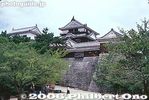
Matsuyama Castle
|
|

Okazaki Castle towerThe castle was dismantled during the Meiji Period and the area was made into a castle park. The castle tower was later rebuilt in 1959.
|
|

Uwajima Castle tower (Important Cultural Property), Ehime Prefecture.
|
|

Occupying a huge plot of land in the center of the city, Kanazawa Castle has undergone extensive renovations and reconstruction. The main castle buildings are now magnificently restored.
|
|

Toyama Castle 富山城
|
|

Entrance to Honmaru Goten palace, Kawagoe Castle.
|
|

Fukuyama Castle tower
|
|

Kameyama Castle was built by Akechi Mitsuhide in the 16th century as his base for his conquered Tanba region.
|
|

Imabari Castle 今治城
|
|

Nakano (Hino Castle) in Hino, Shiga Pref. The castle was built in 1534 by Lord Gamou Sadahide (1508-1579).
|
|

Stairs to Kakegawa Castle tower
|
|

Toyama Castle
|
|

Maruoka Castle tower
|
|

Chiba Castle
|
|
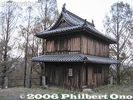
Fukuoka Castle, Kinen Turret祈念櫓
|
|

Twin turrets of Akashi Castle
|
|
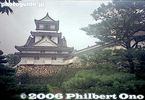
Kochi Castle tower
|
|

Otowa Castle's hilltop center, now a playground.In Hino, Shiga Pref.
|
|
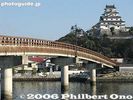
Jonai Bridge to Karatsu Castle城内橋
|
|

Maruoka Castle
|
|

Cherry blossoms and Chiba Castle
|
|

Inuyama Castle tower
|
|

Himeji Castle tower, a National Treasure. 大天守
|
|

Ninomaru Palace entrance, National Treasure. Open to the public, but photography inside is not allowed. 二之丸御殿
|
|

Osaka Castle tower closeup
|
|

Kanazawa Castle
|
|

Roof tiles made of stone on Maruoka Castle
|
|

Takashima Castle
|
|

Inuyama Castle roof
|
|
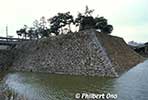
Mihara Castle tenshu main tower foundation and moat. No buildings remain.
|
|

Toyama Castle
|
|

Kumamoto Castle before the earthquake. Unfortunately, it suffered major damage by the Kumamoto earthquake and remains closed. 熊本城
|
|

Kumamoto Castle 熊本城
|
|

Gate to Seta Castle, Otsu, Shiga Pref. 瀬田城跡
|
|

Hachiman-yama Castle wall
|
|
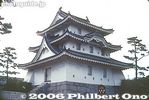
Takamatsu Castle turret
|
|

Yoshida Castle turret
|
|

Kubota Castle
|
|

Hirosaki Castle tower
|
|

Fake castle in Atami, but a landmark nevertheless.
|
|

Iwakuni Castle
|
|

Nagahama Castle, Shiga
|
|
|

Nagahama Castle and cherry blossoms.
|
|
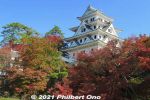
Gujo-Hachiman Castle is on a small mountain named Mt. Hachiman in central Gujo-Hachiman. The main tenshu tower is a 1933 reconstruction made of wood and surrounded by autumn foliage in November.Takes about 15 minutes to climb up. It's a fairly easy climb. The castle has a commanding view of the city.
|
|
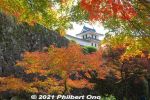
Gujo-Hachiman Castle corner turret and autumn foliage.
|
|
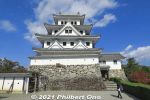
Gujo-Hachiman Castle's tenshu main tower. Reconstruction built in 1933. The original castle was dismantled in 1870 when the samurai system was abolished. Only the stone walls and foundations remained. This reconstruction is unusual because it was built using wood instead of concrete. This is in fact Japan's oldest reconstructed main castle tower made of wood.
Entrance to the castle tower can be seen on the right. Small admission charged.
|
|
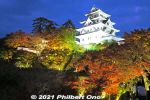
During the autumn foliage, Gujo-Hachiman Castle and autumn leaves are lit up in the evening from 5 pm. No admission charged.
|
|

Hikone Castle's main tower is said to be originally the castle tower for Otsu Castle whose lord was Kyogoku Takatsugu. It was moved here in 1606. This main tower is designated as a National Treasure.
|
|

Although it was a military fortress, Hikone Castle never saw battle and was mainly a symbol of authority.
|
|

Hikone Castle and Genkyu-en Garden in fall
|
|
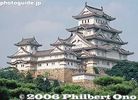
Himeji Castle (National Treasure)
|
|

Hamamatsu Castle is within a wooded park.
|
|

Hamamatsu Castle
|
|

Hamamatsu Castle
|
|

Realistic sculpture of Tokugawa Ieyasu around age 30 in Hamamatsu Castle. Created for Ieyasu's 400th anniversary.
|
|

On the left is the Hamamatsu Castle's main castle tower, and the Castle Gate is on the right. You can enter the Castle Gate.
|
|
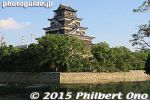
Hiroshima Castle tower is a museum of Hiroshima's history before World War II.
|
|
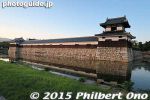
Hiroshima Castle ninomaru turret was reconstructed in 1994.
|
|
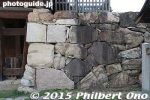
Part of Hiroshima Castle stone wall is black due to the atomic blast.
|
|
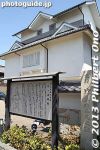
Site of Takehana Castle in Hashima, Gifu, now occupied by the Hashima Folk History Museum.
|
|
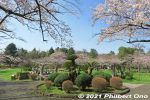
Flowery site of Konodai Castle in Ichikawa, Chiba. No castle buildings. 国府台城跡
|
|

Iga-Ueno Castle and cherry blossoms, Mie Prefecture. During the Meiji Restoration, Ueno Castle's structures were dismantled as with many other castles.
|
|

Iga-Ueno Castle and cherry blossoms, Mie Prefecture.
|
|

Fushimi Turret as seen from Nijubashi Bridge. Edo Castle was first built by Ota Dokan (太田道灌) in 1457 when Tokyo/Edo was still a small fishing village. Ota Dokan is thus regarded as one of Tokyo's forefathers. 伏見櫓
|
|

Fujimi Turret, Edo Castle 富士見櫓
|
|

Foundation of castle tower or donjon. In 1657, there was a great fire in Edo and a stray ember set the castle tower on fire and destroyed it only 19 years after it was built. It was never rebuilt. 天守台
|
|

Otemon Gate, Edo Castle's main gate. 大手門
|
|

Imperial Palace Fujimi turret and Marunouchi office buildings. Tradtional vs. modern.
|
|

Cherry blossoms on Inui-dori, Imperial Palace
|
|

Cherry blossoms on Inui-dori, Imperial Palace
|
|

Saga Castle palace, rebuilt in 2004 after 3 years of construction. 佐賀城本丸歴史館This is a magnificent and accurate reconstruction of the palace built by the 11th Saga lord, Nabeshima Naomasa, in 1838 after a fire razed the castle.
|
|

Imperial Palace Nijubashi Bridge. It is one of Tokyo's symbols. Behind the bridge, you can see Fushimi Turret. This picture was taken on a different day and not while we were crossing the bridge.
|
|

Path to Gifu Castle tower
|
|

Tsu Castle, Ushitora turret
|
|

Azuchi Castle Museum (Azuchi Jokaku Shiryokan)
|
|

Azuchi Castle tower replica at House of Nobunaga. Very ornate and beautiful. both outside and inside.
|
|

Kano Castle as it looked originally in Gifu. 加納城
|
|
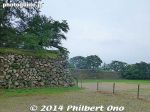
Kano Castle stone walls. Near JR Gifu Station's south exit.
|
|
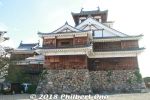
Rear view of Fukuchiyama Castle.
|
|
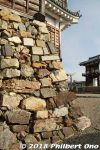
Fukuchiyama Castle is also noted for its stone walls using stones that were originally something else, like gravestones, stone lanterns, and even Buddha stone statues (転用石).Fukuchiyama, Kyoto Prefecture.
|
|
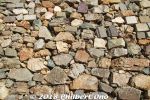
You might think that castle lord did not have enough money to procure enough stones for the walls. Or maybe he was in a real hurry to build the castle and used any stones he could find. In such cases, it would be embarrassing for the lord.
|
|

But these unconventional stones have been placed in prominent places so people can see them. So prevailing theory is, these stones (many are upside down) were to show that the castle lord and the local people were working together since only the local people could obtain these gravestones, etc. Gravestones and stone Buddhas also contain ancestral spirits so embedding them in the castle walls give more power to the castle.
|
|

Front (entrance) view of Fukuchiyama Castle. Inside is a modern building housing a local history museum. Although Fukuchiyama Castle was occupied by a number of lords, it is most strongly associated with Akechi Mitsuhide who built it and occupied it for only three years before he was killed by Toyotomi Hideyoshi in 1582 for assassinating Oda Nobunaga. Fukuchiyama, Kyoto Prefecture.
|
|

Kiyosu Castle, Aichi Prefecture. Oda Nobunaga moved to Kiyosu Castle from Nagoya Castle in 1555. From Kiyosu Castle, he went to defeat the Imagawa at the Battle of Okehazama.
|
|

Kiyosu Castle
|
|

Kiyosu Castle tower and rock garden. 300 yen admission for the castle tower. Open 9 am to 4:30 pm. Closed Mon. (open if a national holiday).
|
|

Kiyosu Castle's 2nd floor includes this mannequin setup showing Oda Nobunaga and his cohorts.
|
|

Kishiwada Castle
|
|
|

Kishiwada Castle moat
|
|

Kaminoyama Castle, Yamagata Pref. The building is four stories high reconstructed in Nov. 1982. The design is based on the castle existing in 1535.
|
|
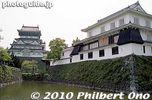
Kokura Castle, Kita-Kyushu
|
|
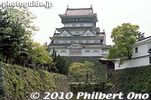
Kokura Castle
|
|
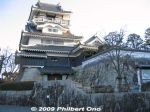
Koyama Castle in Yoshida, Shizuoka. It is modeled after Inuyama castle and does not reflect the design of the original Koyama Castle.
|
|
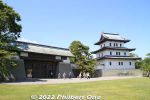
Matsumae Castle's main tower was destroyed by a fire in 1949. The current castle tower is a 1960 reconstruction, serving as a local museum. Only the gate on the left is an original structure from the 19th century. National Important Cultural Property
|
|
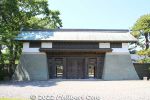
Matsumae Castle's Honmaru Gomon Gate, a National Important Cultural Property. 本丸御門
|
|

Ogurayama Castle on a hilltop. Originally built by Kanamori Nagachika (1524–1608) 金森長近 in 1605 as a retirement residence. Now part of Ogura Park in Mino, Gifu Prefecture. 小倉山城跡The turret is a reconstruction.
|
|

Minakuchi Castle was originally built in 1634 as a rest place for shogun Tokugawa Iemitsu during his travels to and from Kyoto. But the shogun stayed at the castle only once.
|
|

Built in 1611, Matsue Castle is Japan's latest and fifth castle whose main tower tower has been designated as a National Treasure (on July 8, 2015).Matsue Castle is open 8:30 am to 6:30 pm (or 5 pm during Oct. to Mar.). No holidays. Admission is ¥280 for foreigners. Combination ticket that includes admission to the Lafcadio Hearn Museum is also available.
|
|

Matsumoto Castle
|
|
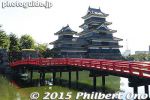
The red bridge provides a nice accent for the Matsumoto Castle tower.
|
|
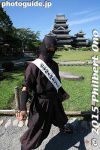
Koka ninja greets visitors to Matsumoto Castle in Matsumoto, Nagano.
|
|

Nagoya's new Hommaru Palace is right next to the tenshukaku main castle tower.
|
|

Reconstructed in 1959 in ferro-concrete, Nagoya Castle's main tenshu tower has closed on May 6, 2018 to start its monumental reconstruction. 天守閣This main tower used to house a museum. The top floor had a lookout deck with fine views.
|
|

Nagoya Castle, Northwest corner turret. 西北隅櫓
|
|
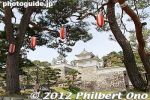
Nihonmatsu Castle, also popularly called Kasumigajo Castle, is on a low hill amid the flat plains of central Nihonmatsu, Fukushima. It is one of Japan's 100 Famous Castles as well as one of Japan's 100 Famous Cherry Blossom Sites.
|
|
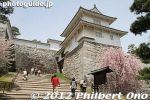
The steps lead to Minowa Gate. 箕輪門
|
|
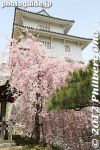
Weeping cherry tree and Nihonmatsu Castle's Minowa Gate.
|
|
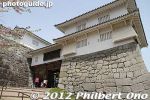
Nihonmatsu Castle's Minowa Gate was reconstructed in Aug. 1982 at a cost of 200 million yen. 箕輪門
|
|
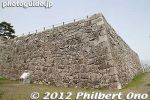
Nihonmatsu Castle's old stone wall originally built by Gamo Ujisato.
|
|

Panorama of Nihonmatsu Castle's Honmaru.
|
|
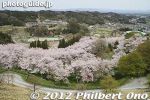
Marvelous views of cherry blossoms from Nihonmatsu Castle's Honmaru.
|
|
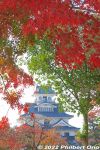
Nagahama Castle and autumn foliage, Shiga Prefecture.
|
|
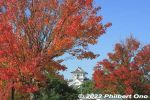
Nagahama Castle and autumn foliage, Shiga Prefecture.
|
|
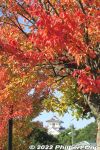
Nagahama Castle and autumn foliage, Shiga Prefecture.
|
|

Obama Castle stone foundation for the main castle tower. No structure remain. No moats remain either, except for the two rivers which served as a natural moat.
|
|
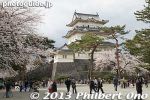
Odawara Castle, Kanagawa Prefecture
|
|
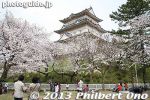
Odawara Castle has this one little picnic spot nearby.
|
|

Ogaki Castle's cherry blossoms were more beautiful than I had expected.
|
|

Ogaki Castle in April
|
|
|

Ogaki Castle and cherry blossoms
|
|

Okayama Castle 岡山城
|
|
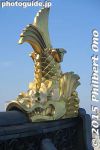
Shachihoko roof ornament on Okayama Castle.
|
|
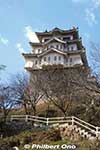
Onomichi Castle (tourist facility). The castle was finally dismantled in 2020-21. A very slow process since heavy duty equipment cannot access the structure.This is not based on an actual castle, but built as an amusement attraction. Now closed.
|
|

Kawamori Castle, Ryuo-cho, Shiga 川守城跡 MAP
|
|

Shibata Castle, Niigata (Sangai Yagura Turret)
|
|

Sangai Yagura Turret, Shibata Castle 三階櫓, Niigata. The castle never had a tenshukaku castle tower (donjon), so this turret was the grandest castle structure.
|
|
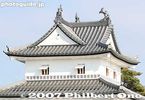
Sangai Yagura Turret with three shachi sculptures on the T-shaped roof. Unique to Shibata Castle. Unfortunately, we cannot enter this turret since it is within the Ground Self-Defence Force base which occupies much of the castle grounds.
|
|

Sendai Castle's Waki-yagura turret at the site of Otemon Gate. Reconstructed in 1965. We cannot enter it. 脇櫓
|
|

Waki-yagura turret at Sendai Castle.
|
|

View from Sendai Castle's Honmaru. Sendai has over a million people. On clear days, you can also see the Pacific Ocean.
|
|

Statue of Lord Date Masamune at Sendai Castle's Honmaru.
|
|

In Nagasaki Prefecture, Shimabara Castle is the picturesque symbol of the city. Short walk from Shimabara Station (Shimabara Railway that starts from Isahaya Station).
|
|

Shimabara Castle was the government headquarters of the Shimabara Domain until 1871. Shimabara Castle's tenshu main tower and a corner turret (foreground).
|
|
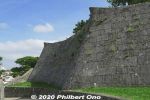
Shuri Castle wall with pointy tips.
|
|
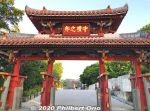
The reconstruction of Shureimon was the start of a decades-long process to reconstruct the major buildings of the castle, especially the ornate Seiden main hall in 1992. Other castle buildings were also reconstructed and the castle's reconstruction was finally completed in spring 2019. It was a great celebration.
|
|

Shuri Castle's Shureimon Gate 守礼門 also appeared on the defunct ¥2000 bill.
|
|
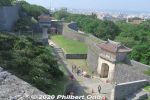
Kankaimon Gate and Kyukeimon Gate.
|
|
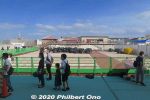
Oct. 31, 2019, the day all of Okinawa cried. Shurijo Castle's Seiden Hall was totally destroyed by fire along with connecting halls. Apparently caused by short-circuited wiring on the left side of the building.After the charred remains were cleaned up, the castle fully reopened to the public in June 2020 with this elevated walkway for visitors to see the ruins and the progress of the castle's reconstruction.
|
|
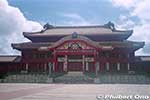
The ornate Seiden Hall, Shuri Castle's most important and central building and National Treasure. Saw it on a previous trip. Very ornate building with wood carvings, lacquered surfaces, paintings, and sculptures. It was meticulously rebuilt in 1992. (首里城 正殿)
Notice the stone dragon pillars flanking the center entrance and sculptures of dragon heads and lion head on the red roof tile roof.
|
|
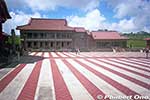
Before the fire, Nanden South Hall (南殿) was connected to the Seiden main hall seen on the left. To enter the Seiden, we had to enter this hall first (entrance on the right). The fire also gutted this building beyond repair and had to be torn down along with the Hokuden North Hall (北殿) on the other side of the Seiden.
Photography inside the main buildings wasn't allowed, so sadly I don't have any photos of the interior.
|
|
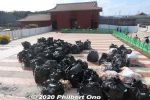
Ideal roof tiles have minimal water absorption and shrinkage. Researchers in Okinawa are testing various clay samples and firing temperatures. They found that the best clay is from the city of Nago, and that's where the clay came from for the Seiden's 1992 reconstruction. However today, there's not enough clay in Nago to make the necessary 55,000 red roof tiles for the new Seiden and other buildings.
So they scoured other locations on the island and found a good source. Now they are trying to figure out how much recycled red roof tile powder should be mixed into the new clay to make the new roof tiles. They want to somehow reuse the old roof tiles.
|
|

Hoshinmon Gate and the Una as seen from the Seiden.This red-and-white plaza is the castle's trademark, the Una courtyard where official ceremonies were held. The red path in the middle was where the King would walk to the main hall.
|
|

Shurijo Castle was the seat of the Ryukyu Kingdom's government from 1429 to 1879 when it became Okinawa Prefecture. The Ryukyuan kings were from the Sho Clan (尚) starting with Shō Hashi who unified the three kingdoms on the main island in 1429. The other islands also eventually came under the control of the Shuri government after successful military campaigns.
|
|

Yaji in front of Sumpu Castle in Shizuoka city. 「東海道中膝栗毛」十返捨一九
|
|

Sunpu Castle's Tatsumi Yagura Turret and Higashi Gomon Gate.
|
|
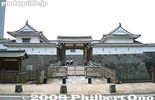
Sumpu Castle's Higashi Gomon Gate and bridge 東御門
|
|

Sunomata Castle and gourd sculpture. The gourd (hyotan) was Toyotomi Hideyoshi's trademark as well as a symbol of this area.
|
|

Sunomata Castle.
|
|

Toba Castle
|
|

The only castle wall remaining at Toba Castle.
|
|

A well remaining at Toba Castle.
|
|
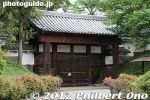
Tatebayashi Castle's Dobashi Gate. 土橋門
|
|
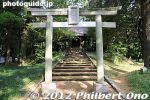
Tatebayashi Castle's Honmaru is marked by this Hachiman Shrine on a mound. Gunma.
|
|
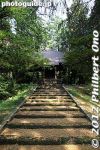
Hachiman Shrine on Tatebayashi Castle's Honmaru, Gunma.
|
|
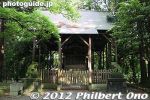
Hachiman Shrine on Tatebayashi Castle's Honmaru. The shrine has a protective housing. Hachiman was the patron god of Tatebayashi Castle, Gunma.
|
|
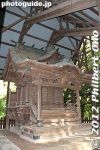
Hachiman Shrine on Tatebayashi Castle's Honmaru. Gunma.
|
|

Tsuwano Castle ruins in Shimane.
|
|

Dressed as Sanada at Ueda Castle, Nagano Prefecture.
|
|

Reconstructed South Turret of Ueda Castle is open to the public.
|
|

North Turret of Ueda Castle.
|
|

West Turret, Ueda Castle's only original structure.
|
|
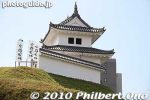
Utsunomiya Castle, Tochigi. Unfortunately, I didn't have time to explore this castle more.
|
|

Utsunomiya Castle, Tochigi Pref.
|
|

Aizu-Wakamatsu (Tsuruga-jo) Castle, Fukushima Pref. The reconstructed castle tower (ferro-concrete) is based on the 5-story castle tower Kato Akinari built in 1639. "Wakamatsu" was named after a place in Hino, Shiga by Ujisato.
|
|

Wakamatsu Castle, Fukushima. Totally modern on the inside (renovated in 2004), the castle tower is a history museum. It displays swords and portraits of the Byakkotai Battalion of teenagers who valiantly butneedlessly committed suicide on Iimoriyama Hill.
|
|

Wakayama Castle
|
|

Wakayama Castle's main castle tower is connected to a corridor leading to two other turrets. On the left is the entrance to this castle tower complex (tenshu-kuruwa 天守郭).
|
|

Cherry blossoms and Wakayama Castle tower.
|
|

Wakayama Castle as seen from Inui Turret.
|
|

Yamagata Castle's Ninomaru Higashi Otemon Gate. This gate and turret were accurately reconstructed in 1991 based on Edo Period documents and Meiji Period photos. 二の丸東大手門
|
|

Behind Ninomaru Higashi Otemon Gate
|
|

Inside the Ninomaru Higashi Otemon Gate turret at Yamagata Castle. Very impressive construction. Still new-looking even after almost 20 years.
|
|
|
|
|